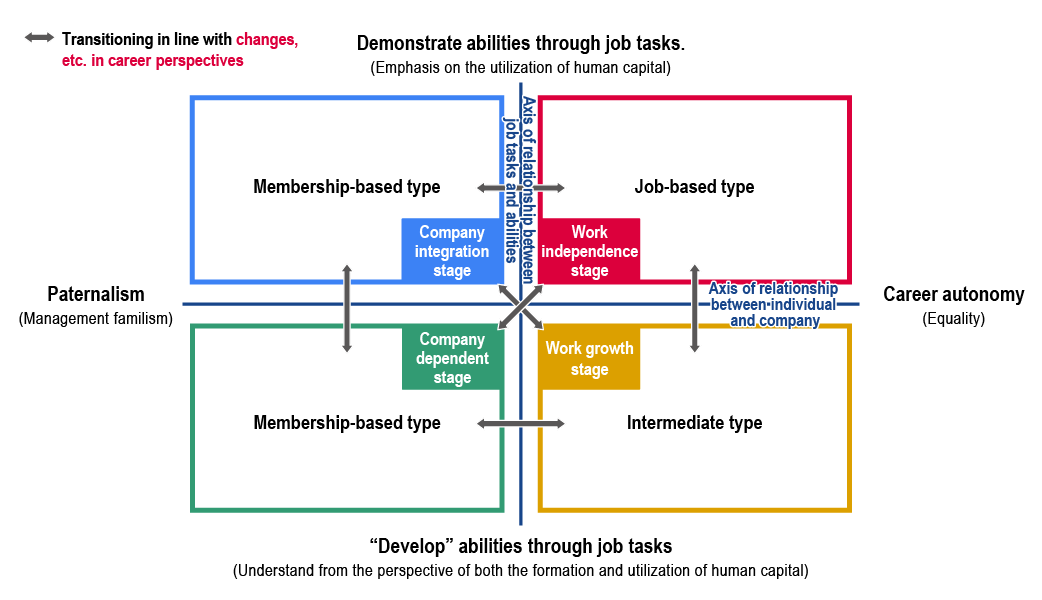The Mitsubishi Research Institute, Inc.—located in Tokyo and lead by President Kenji Yabuta—published a report on its research, conducted with other corporations and academia, on the concept of a hybrid employment system. The report is intended to serve as a catalyst for a new system of human resource rules and management. Such a new system can help companies to implement human resource strategies in line with overall management strategies. It can also help employees to find self-fulfillment and play an active role according to their own career philosophies.
New Research on Developing a Hybrid Employment System
2022.2.10
1. Building a Hybrid Employment System
The research defined six employee types by plotting employee-survey results across four unique career stages that were based on the relationship between capabilities and job content, as well as employees and employers. Employers must operate in a way that combines employment systems that are suitable for each career stage. The result is a hybrid employment system that supports employee skill development, enables transitions between work stages, increases the employer’s capabilities, and fosters an equal relationship between employees and employers.
Defining the hybrid employment system
The typical company features only one structure in its employment system, which spans capacity development, organizational development, and the assignment and treatment of employees. However, a hybrid employment system unifies the spectrum of employee types. These types include membership types, job types, and intermediate types, the latter featuring aspects of both the membership and job types. Fully inclusive talent management (FITM) can be achieved by managing by employee-type groups, and thus management becomes possible that takes into consideration the diverse career philosophies of employees.
The report covers the fundamentals behind the development and operation of a hybrid employment system, as outlined below. Each employer must put together specific implementation methods and content in light of its own situation, such as organizational size, industry, business model, and employee demographics.
The report covers the fundamentals behind the development and operation of a hybrid employment system, as outlined below. Each employer must put together specific implementation methods and content in light of its own situation, such as organizational size, industry, business model, and employee demographics.
2. The Development Process
First, the organization must define the ideal human resource portfolio for each career stage based on the organization's overarching management policies and human resource master plan. Next, employers must gain a full understanding of current employee intentions. Finally, the employer will identify policy measures to shift employees to the ideal career stage.
Defining the four career stages (refer to diagram)
- The vertical axis represents the relationship between capabilities and job content, and the horizontal axis represents the relationship between employees and employers
- Career stages are positioned among the resulting four quadrants and represent an employee’s career philosophy and psychological relationship with the employer
- The employee types, such as the membership and job types, are also positioned in each quadrant. The bottom-right quadrant cannot be strictly defined as either membership or job, and has been defined as an intermediate type
The relationship between the multiple career-stage based employment systems

Source: Mitsubishi Research Institute, Inc.
Clarifying employee diversity through six employee types
Employees demonstrate a wide range of characteristics and tendencies at each career stage. The research project included a questionnaire survey of 3,000 full-time employees nationwide. Cluster analysis provided the basis for identifying six types of employees. Human resource management that takes into consideration the diversity of employee values can be achieved by providing employees with work stages that feature measures effective in enhancing engagement and performance for each employee type.
[Employee type 1] Competitive elite (Company integration stage)
[Employee type 2] Autonomous job growth (Work growth stage)
[Employee type 3] Work-oriented generalist (Work growth stage)
[Employee type 4] Autonomous career (Work growth stage)
[Employee type 5] Solitary WLB-focused (Work growth stage)
[Employee type 6] Passive-adaptive WLB-focused (Work growth stage or Work independence stage)
[Employee type 1] Competitive elite (Company integration stage)
[Employee type 2] Autonomous job growth (Work growth stage)
[Employee type 3] Work-oriented generalist (Work growth stage)
[Employee type 4] Autonomous career (Work growth stage)
[Employee type 5] Solitary WLB-focused (Work growth stage)
[Employee type 6] Passive-adaptive WLB-focused (Work growth stage or Work independence stage)
3. Operational Methodology
Hybrid employment systems should be operated according to three primary steps:
- Improving the work environment in the work growth and work independence stages. These stages are expected to be particularly suitable for employee activity in the future. This can include measures for organizational development and employee capacity development
- Using inclusive talent management to shift more employees to the work growth and work independence stages
- Supporting the employability of the workforce. This facilitates enhanced engagement, increased productivity, and an equal relationship environment—all leading to a changing role for employers in the securement of employment
For Inquiry
Mitsubishi Research Institute, Inc.(MRI)
10-3, Nagatacho 2-chome, Chiyoda-ku, Tokyo 100-8141
Study Group on New Employment System, Career Innovation Division
Ryuichi Okumura, Yoshiki Shimizu
E-mail: employment_system@ml.mri.co.jp
10-3, Nagatacho 2-chome, Chiyoda-ku, Tokyo 100-8141
Study Group on New Employment System, Career Innovation Division
Ryuichi Okumura, Yoshiki Shimizu
E-mail: employment_system@ml.mri.co.jp
